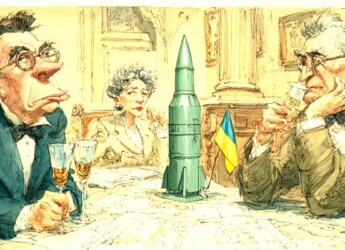|
|
Content Assessment: The War on Data? Artificial Intelligence and Autonomous Systems Through the Lens of NATO
Information - 93%
Insight - 91%
Relevance - 84%
Objectivity - 90%
Authority - 94%
90%
Excellent
A short percentage-based assessment of the qualitative benefit of the post highlighting a recent report and corresponding appendix on AI and autonomy in the military.
Editor’s Note: From time to time, ComplexDiscovery highlights publicly available or privately purchasable announcements, content updates, and research from cyber, data, and legal discovery providers, research organizations, and ComplexDiscovery community members. While ComplexDiscovery regularly highlights this information, it does not assume any responsibility for content assertions.
To submit recommendations for consideration and inclusion in ComplexDiscovery’s cyber, data, and legal discovery-centric service, product, or research announcements, contact us today.
Shared* with permission for educational use from the NATO Cooperative Cyber Defence Centre of Excellence (CCDCOE), the following report and corresponding appendix highlight strategies and deployments of artificial intelligence (AI) and autonomous systems by NATO member states. This report and appendix may be useful for cybersecurity, information governance, and eDiscovery leaders as they consider the challenges of developing, deploying, and managing AI in areas ranging from system automation and autonomy to data analysis and decisions.
Report by Maggie Gray and Amy Ertan, NATO CCDCOE
Artificial Intelligence and Autonomy in the Military: An Overview of NATO Member States’ Strategies and Deployment
Introduction – Extract
Across many spheres, artificial intelligence (AI) is expected to transform basic tasks and processes in ways that promise to fundamentally change the nature of work. In the defense domain, AI is an emerging technology that has been incorporated into a wide range of applications from autonomous vehicles to data processing and logistics tools. This paper offers a high-level view of the role of AI-enabled and autonomous technologies in the militaries of NATO Allies as of January 2021. The following overview of doctrine and individual state policy does not attempt to provide exhaustive coverage of each state’s programs and AI-enhanced military capabilities but instead aims to offer a snapshot of the perspectives, outlook, and maturity each state holds in relation to military AI innovation. While other papers have examined the role of AI in the military, many focus on ethics and theory, and none have focused specifically on NATO. Research on military AI in practice tends to examine the US, China, and Russia, largely ignoring smaller countries. However, this report aims to study military AI in all NATO countries.
Common Challenges and Vulnerabilities of AI and Autonomous Systems – Extract
In examining the approach of NATO members to AI-enabled military systems, it is critical to examine the potential problems with and vulnerabilities in AI systems to understand relevant challenges and implications. While AI may help significantly improve military systems in the future, current capabilities are far from perfect, and particularly in the military sphere, mistakes may have serious consequences. Current AI technology is brittle, meaning that it only works in very specific situations. When presented with a task or environment that differs slightly from the data it was trained on or its pre-set parameters, an AI system can fail spectacularly, potentially leading to a military crisis. In a similar vein, second-wave AI algorithms like ML algorithms are only as good as the data they are trained on. ML algorithms use pre-labeled datasets to build statistical models that dictate their behavior, but it is difficult to get high-quality, large pre-labeled datasets containing military data. Real-world military data tends to be highly classified, and there may not be enough to adequately train an ML system. Instead, many military ML algorithms would need to be trained on simulation data, which may not accurately represent the real world, especially for safety-critical systems.
AI Strategies and Deployment - NATO CCDCOE
Read the Report Appendix A – Country Profiles (PDF) – Mouseover to Scroll
AI Strategies and Deployment - Appendix A - NATO CCDCOE*Shared with permission for educational use.
CCDCOE Sources
- Gray, M. and Ertan, A., 2021. Artificial Intelligence and Autonomy in the Military: An Overview of NATO Member States’ Strategies and Deployment. [online] Tallinn: The NATO Cooperative Cyber Defence Centre of Excellence. Available at: <https://ccdcoe.org/uploads/2021/12/Strategies_and_Deployment_A4.pdf> [Accessed 14 December 2021].
- Gray, M. and Ertan, A., 2021. Artificial Intelligence and Autonomy in the Military: An Overview of NATO Member States’ Strategies and Deployment – Appendix A – Country Profiles. [online] Tallinn: The NATO Cooperative Cyber Defence Centre of Excellence. Available at: <https://ccdcoe.org/uploads/2021/12/Strategies_and_Deployment_Appendix-A_A4.pdf> [Accessed 14 December 2021].
Additional Reading
- Defining Cyber Discovery? A Definition and Framework
- Cybersecurity Challenges for Artificial Intelligence: Considering the AI Lifecycle
Source: ComplexDiscovery



























